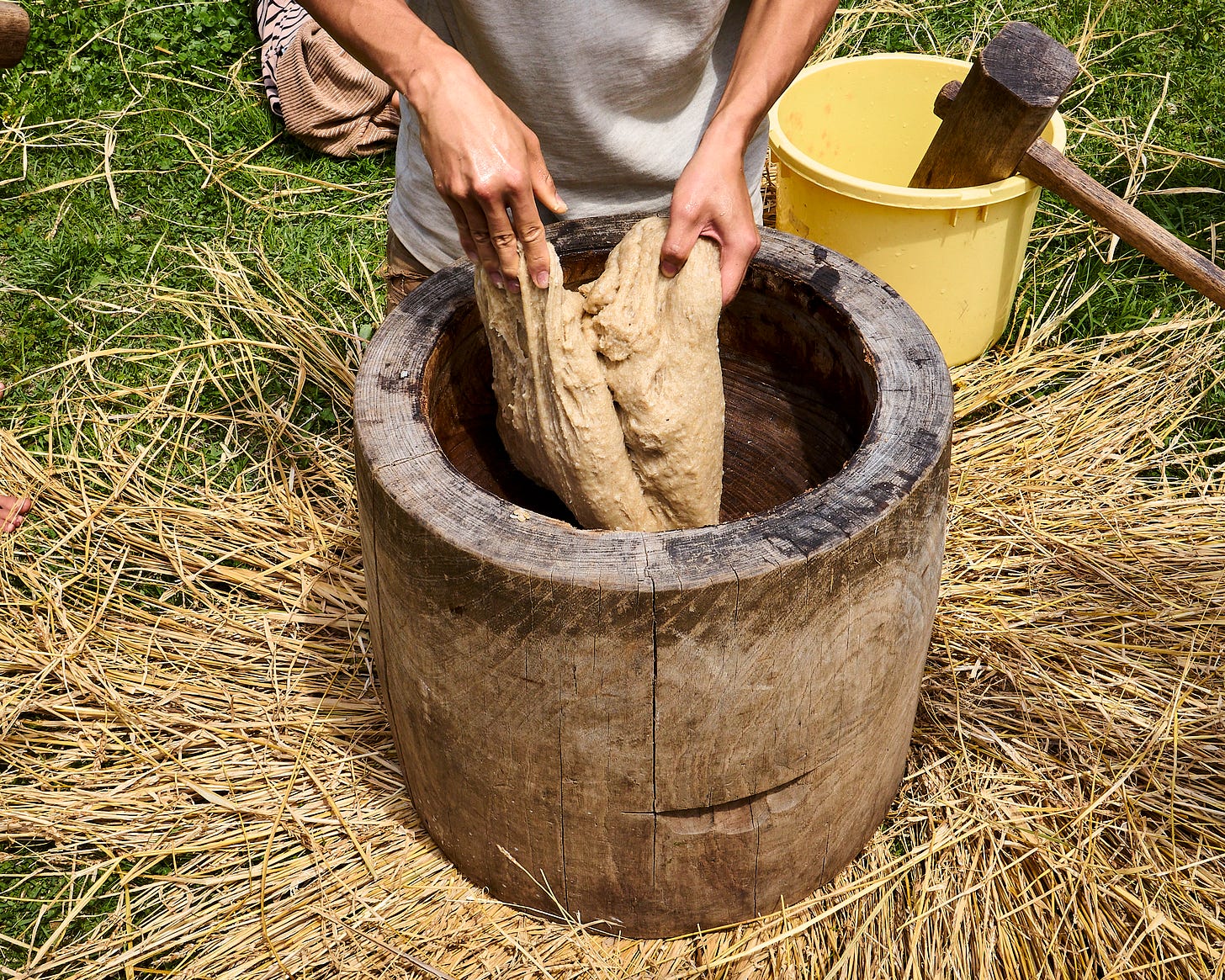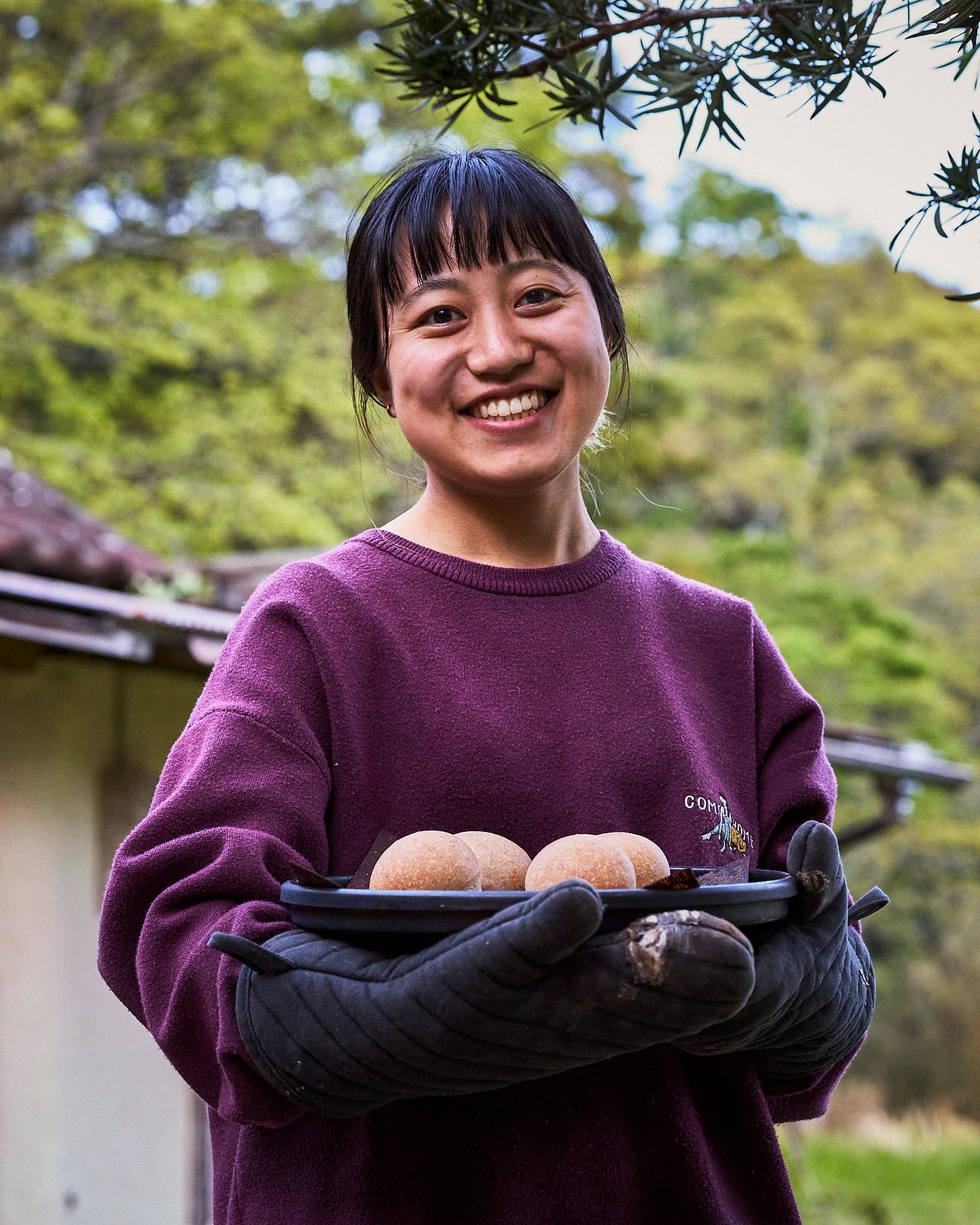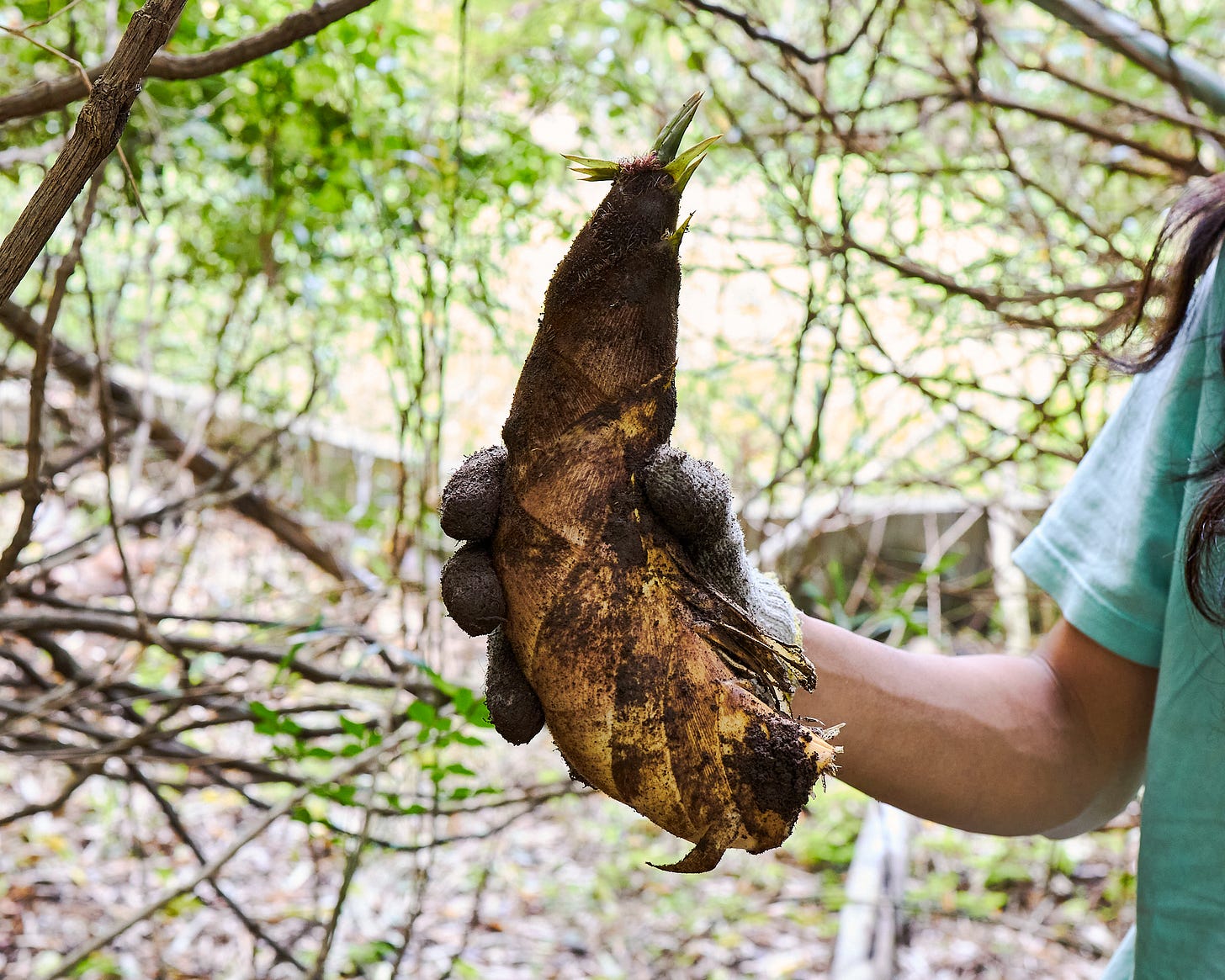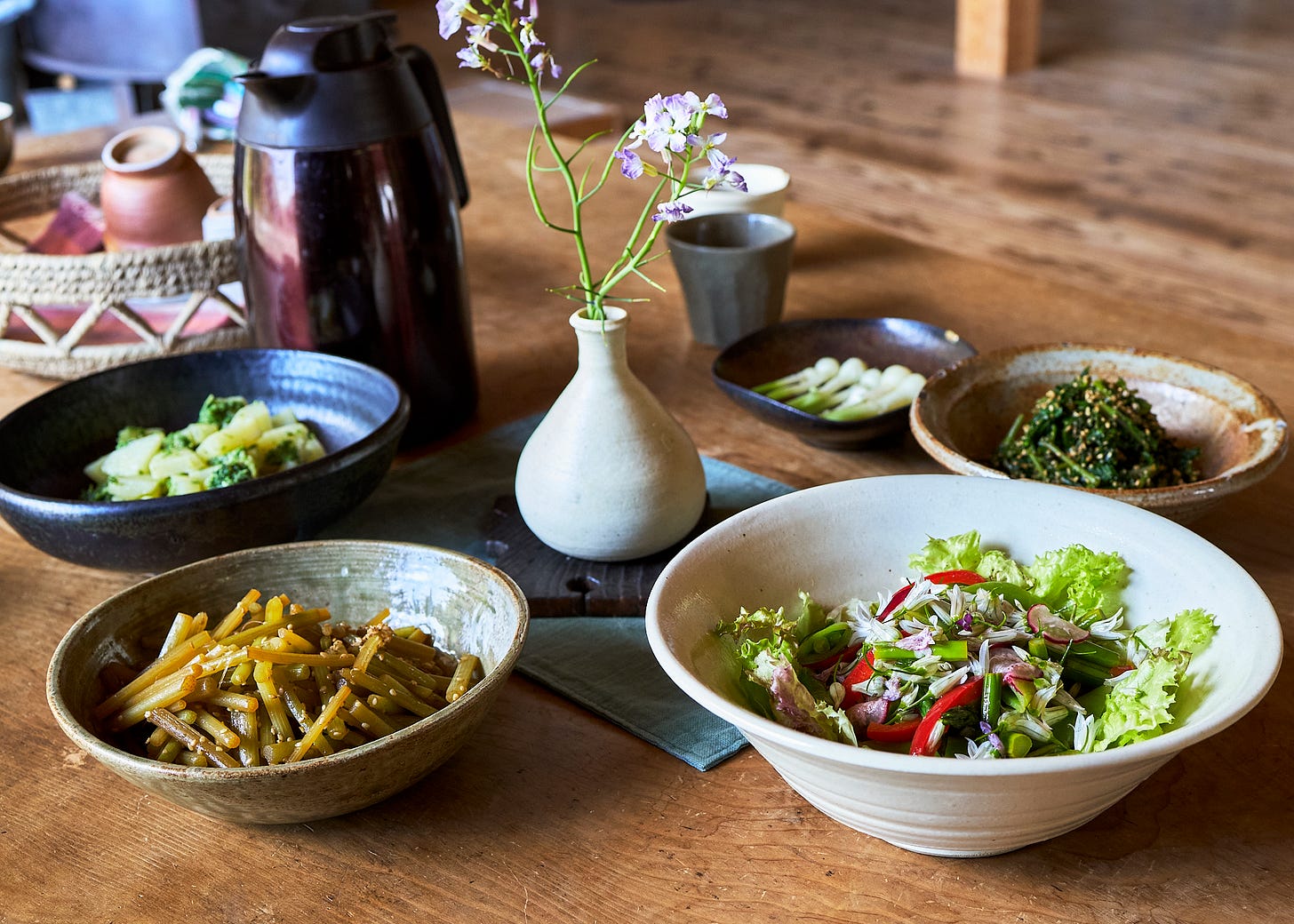As I look back, it’s clear to me that my favorite moments are always those that are spent with people around a table with food. The joy lies in the story behind the dish and discovering that story with one another. Food is a wonderful vehicle for self-expression and as an art form. It can reflect the journey of the ingredients from the land to the plate. A dish may symbolize ancestral knowledge, dedication to a craft, or simply one’s passion. That experience of all of us tasting something for the first time together, and sharing every bit of information that hits our taste buds whether it’s with words or reactions, is what I live for.
My deep appreciation for food was one of the core principles that jump-started my journey to Japan, in search of delving deeper into their culinary art and traditions. In the last three weeks of my apprenticeship at Brown’s Field, I’ve been trying a wide array of dishes. Each dish is always plant-based, with a focus on using locally grown and organic vegetables, as well as homemade ingredients from shoyu to ume-su. Some of my favorite dishes at Brown’s Field as of late are:
Crispy Takenoko Karaage by Sori-Chan
Multi-layered Parfait with anko, black sesame ice cream and yomogi bread by Kao-Chan
Salted Focaccia with edible flowers by Tommy
Olive Oil Gohan and Panko Potato Croquettes by Minami
Miso Coated, Oven Roasted Peanuts by Sac-Chan
Creamy Tonyu Mayonnaise by Deco-San
I love seeing how the family here reacts after the first bite of food during our shared lunches or dinners. Every bite is usually followed by one of us uttering “Oishii! - delicious!” and making sounds of pleasure. Much of the food I’ve tasted here is subtle and yet remarkably complex. Because of the subtlety, I’ve noticed that in order to taste it all, you really have to be experiencing the present moment. I’ll explain two ways I’ve been going about it. The first method was shared by Minami, one of the Chef’s at the Brown’s Field Rice Terrace Cafe. When eating, she likes to close her eyes with each bite of food. Doing so helps her focus more on the taste, texture, and smell. Like Minami, doing so gives me a greater opportunity to reflect on all the information my body receives from each savored bite of food.
The second method has to do with the phrase “itadakemasu.” Before every meal, we as a family say itadakemasu, which in Japanese culture, is a polite way of saying that you feel a sense of gratitude for the meal before you. After saying itadakemasu, we then rest our hands together, bring them close to our chest, close our eyes, and center ourselves. We rest in that moment for as long as we’d like before we begin eating. Similar to that of Minami’s method, the moment of centering myself after saying “itadakemasu!” gives me a chance to take multiple conscious deep breaths, clear my mind, and focus on the energy, dedication, and flavors put into the dish. It’s transformed the way I experience food.
Not all transformations in this journey thus far revolves around just eating. They also revolve around actually doing the cooking! For instance, Tommy — a farmer at Brown’s Field and an incredible cocktail artist — & I recently organized a plant-based, farm-to-table pop-up at Brown’s Field on April 30th. For the food portion, I offered a dinner plate with six items in total, which included items such as maitake & tofu tacos, fried enoki with a bell pepper cashew sauce, and a takenoko kabosu salad. To play along with the menu theme, Tommy made shiitake infused mezcal for an original cocktail of his called “Munchy Fist.” His cocktail was incredibly balanced with underlying notes of umami and citrus. I could go for another one as I write this.
The menu was a fusion, incorporating locally available ingredients and drawing in inspiration from foods from my upbringing. Being born and raised in California, it was not uncommon to eat tacos regularly. In Japan… it’s not so common. I thought it would be exciting to introduce a take on tacos but with a twist: Maitake & tofu as the main “meat,” cooked in a wok with shio koji, shoyu, mirin, and spices. The tacos were topped with negi, locally grown chopped peanuts, and a tonyu mayonnaise inspired by Deco-San’s, but with added kabosu juice, chili powder, and seasonings.
The takenoko salad was inspired by the ceviche a manager of mine used to give me at one of my first food related jobs 12 years ago. Instead of shrimp or a white fish, I chopped freshly harvested takenoko and cooked it in shoyu and sake. Afterwards, it was mixed with kabosu and lime juice, fresh coriander leaves, tomato, onion, avocado, olive oil, salt, and pepper. This sort of, no boundaries and anything goes menu changed my outlook on cooking by giving me a new sense of creative freedom.
There is a sense of challenge every time I cook here because I’m surrounded by foods that are unfamiliar, the absence of familiar pantry items and cooking tools, and the limitations of ingredients available here in Isumi, Chiba. Despite the challenges, there’s been a constant sense of reward and growth. Every chance to share myself through food that I have cooked has been fulfilling.
One of the most insightful culinary trainings I have ever had was on a recent day off. Minami, Kao-Chan and I drove about an hour out from Isumi to a small home located up in a quiet mountain side overlooking a beautiful forest below. The home is owned by Miho Yoneyama, a talented chef, who was kind enough to share her knowledge about native and foreign foliage growing in Japan. As we walked around her property, she would point to various plants while explaining what was or wasn’t edible. Some examples of the edible plants were:
Yomogi which is like mugwort, and can be made into powders and used in baked goods such as bread or in dango. The flavor reminds me of matcha.
Fuki, a fibrous vegetable stem that is great for stir-frys.
Karasu-no-endo, a plant which grows beautiful, tiny purplish pink flowers that are great for adding color to dishes.
After the first lesson, we were tasked with foraging the plants ourselves for an upcoming shared lunch where Miho Yoneyama would demonstrate how to use the plants in various dishes. One of my favorite plants that we foraged is actually an invasive species of Mediterranean descent. It’s called the mitsuka-do-negi or three-corned leek. This one in particular grows white flowers that tantalized my taste buds as its petals tasted like a mild white onion.
Post-cooking class, Minami now occasionally sends me out to forage wild flowers and edible plants for the Rice Terrace Cafe. This act of collecting and borrowing from the land makes me feel more connected and thankful for the environment around us, a sentiment I deeply expressed in my first journal entry. I feel a great sense of joy when I witness a customer’s response to seeing their plate of food filled with ingredients that gives the dish so much life.
With each day packed with activities and socializing, my time to reflect is limited. I often wonder how this journey will affect me when the time comes to fly back to California. How will I use this new knowledge about sustainable living in my day to day as well as my professional life? Even with limited time to reflect, one thing was apparent each time I sat down with my Brown’s Field family to eat a meal: I wasn’t ready to say goodbye. I wasn’t ready to give up these moments of utter inspiration after every bite of food. I still wanted to observe, and learn, and have a chance to say “oishii” to whoever the chef is for that day.
On May 11, instead of following my initial plan of boarding a plane to fly from Tokyo back to California, I decided to stay exactly where I was. Here’s to three more weeks in Japan!
- The Climate Foodie
A Field of Flowers
There isn’t a new recipe to share for this week. Instead, please enjoy this view of a field of nemophila flowers from a recent trip to Hitachi Seaside Park, located in Ibaraki Japan.














